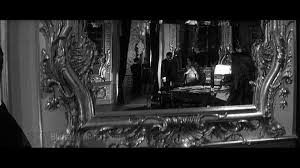Dariush Mehrjui, 1969, Iran, 115m, "Gaav"
Hassan loves his cow, the only cow in the mud caked, sand blown village, in an age before electricity. He bathes the cow, talks to her, laughs with her. The bond between cow and man is extraordinarily powerful :emotional, spiritual, obsessive. But the star crossed love is smitten with incomprehensible tragedy, as the beloved dies suddenly, while he is away for a day. He cannot bear the shock. As he pines away, he gradually comes to believe he himself is the cow. A rare brand of insanity indeed as he turns into the deceased animal. We find him chewing away at the hay, big eyed and uncomprehending, bellowing furiously at the considerate neighbors who want to care for him. Well, this may verge on the ludicrous, but the film is profoundly tragic, as a man sinks into insanity beyond redemption, metamorphing into a different species.
In the process, we see the life in the village, which could be the stone age or millenia ago, but actually is very like what might have been in this part of the world a century ago. The environment is familiar to me from what I have heard from my own elders. The close neighborlinesses of the villagers, as they join in grief and festivity, is a picture of social symbiosis which has disappeared. The grief of the beloved Hassan as he sinks irretrievably into his delusions, becomes the common concern and grief of all the village. And then the village is regularly terrorized and plundered by a tribe of bandits and the shared peril draws them together. This impoverished and tightly bound fraternity of good people brings in me a feeling of nostalgia for places I know only from hearsay.
This is a strange, powerful, imperfect film. The background score, using indigenous string instruments is evocative of the heart wrenching pains of this semi pre-historic existence. The palette is a bit too dark. The village streets, the mischievous urchins tormenting the village idiot, the pathetic pots and pans,and the minimality of life's resources, is captured in the sensitive cinematography.
A deeply felt film. Hassan is a tragic and human figure. The director makes him entirely credible, though he borders on absurdity. This is the stuff of mythology, folk lore, the workings of the deeper strata of the mind. It is a portrait of an ordinary human being when confronted with the essential enigma. It is like Lear and his nevers. And it speaks the language sheerly of the heart, not the intellect.
Thanks to Nathanael Hood for introducing this film. His far more comprehensive review is HERE
Hassan loves his cow, the only cow in the mud caked, sand blown village, in an age before electricity. He bathes the cow, talks to her, laughs with her. The bond between cow and man is extraordinarily powerful :emotional, spiritual, obsessive. But the star crossed love is smitten with incomprehensible tragedy, as the beloved dies suddenly, while he is away for a day. He cannot bear the shock. As he pines away, he gradually comes to believe he himself is the cow. A rare brand of insanity indeed as he turns into the deceased animal. We find him chewing away at the hay, big eyed and uncomprehending, bellowing furiously at the considerate neighbors who want to care for him. Well, this may verge on the ludicrous, but the film is profoundly tragic, as a man sinks into insanity beyond redemption, metamorphing into a different species.
In the process, we see the life in the village, which could be the stone age or millenia ago, but actually is very like what might have been in this part of the world a century ago. The environment is familiar to me from what I have heard from my own elders. The close neighborlinesses of the villagers, as they join in grief and festivity, is a picture of social symbiosis which has disappeared. The grief of the beloved Hassan as he sinks irretrievably into his delusions, becomes the common concern and grief of all the village. And then the village is regularly terrorized and plundered by a tribe of bandits and the shared peril draws them together. This impoverished and tightly bound fraternity of good people brings in me a feeling of nostalgia for places I know only from hearsay.
This is a strange, powerful, imperfect film. The background score, using indigenous string instruments is evocative of the heart wrenching pains of this semi pre-historic existence. The palette is a bit too dark. The village streets, the mischievous urchins tormenting the village idiot, the pathetic pots and pans,and the minimality of life's resources, is captured in the sensitive cinematography.
A deeply felt film. Hassan is a tragic and human figure. The director makes him entirely credible, though he borders on absurdity. This is the stuff of mythology, folk lore, the workings of the deeper strata of the mind. It is a portrait of an ordinary human being when confronted with the essential enigma. It is like Lear and his nevers. And it speaks the language sheerly of the heart, not the intellect.
Thanks to Nathanael Hood for introducing this film. His far more comprehensive review is HERE

